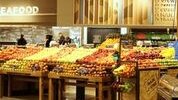Could Kroger open its farm market concept stores in Cincinnati?
Kroger Co. could open more than a dozen of its Main & Vine fresh and local small-store locations in Greater Cincinnati, according to an in-depth analyst report.
Vince Sinisi, a Morgan Stanley analyst who follows Cincinnati-based supermarket operator Kroger (NYSE: KR), figures Kroger could open as many as 15 of its Main & Vine stores in Greater Cincinnati in coming years.
Cincinnati’s penchant for organic food, market size and demographics make it a likely candidate, Sinisi said in his report that included a deep dive into Main & Vine's potential.
He named Cincinnati as one of 16 markets around the country that would likely be suitable candidates for a big expansion of Main & Vine if Kroger decided to do that. He estimates Kroger could open 300 Main & Vine stores across its chain.
Kroger has just one Main & Vine store now in Gig Harbor, Wash., near Tacoma. It opened that store in February.
Kroger executives haven’t indicated they will expand Main & Vine. Company officials wouldn’t comment for this story.
Main & Vine focuses primarily on fresh items such as produce. It puts organic produce at the center of the store and includes booths for local farmers and artisans to sell their wares. The farm market-type concept stores also offer frequent cooking and food preparation education sessions.
“The store highlights various community-focused initiatives, which we believe can make the stores more of a community destination than a typical grocery store,” Sinisi wrote in his report. “With these qualities, we believe Main & Vine is well positioned to gain share within the key growth segments of natural/organic and local.”
The store is small at 30,000 square feet. That’s three to five times smaller than a typical Kroger store. And it aims to keep prices cheaper than other specialty food stores.
Sinisi said he found Kroger’s natural and organic items cost an average of 10 percent less than at the typical regional conventional food retailer, a gap that has widened lately.
Kroger CEO Rodney McMullen told me in a June interview that Kroger could expand the concept once it learns from the first store.
“We’re still learning what parts of the store the customer likes and what parts the customer isn’t as enamored with,” he said then. “There are already changes we’ve made based on that initial customer feedback and changes in terms of some of the products we carry.”
Kroger, which has nearly 2,800 stores, tends to learn at one or a few stores before expanding broadly, McMullen said.
“It’s trying to learn on a small scale and understand what works,” McMullen said. “We would scale after that. This isn’t any different. There are elements we’re starting to learn at Main & Vine. Every night, we have a person preparing a meal and you can try it and you can buy it. Once they started to understand what we have there, the customers are starting to engage in that pretty aggressively.”
Sinisi selected markets that rank in the top half for organic food purchases as a percentage of all packaged food sales among the 60 largest markets. He also looked for markets with more than 250,000 households that meet demographic criteria for age, income and grocery store identity.
Sinisi also studied Sprouts Farmers Market and Lucky’s, a similar chain in which Kroger has an investment, to come up with an average store density figure of about one store per 60,000 households.
Jim Hertel, senior vice president at Long Grove, Ill.-based food retail consultant Willard Bishop, an Inmar Analytics company, told me Kroger is likely focused first on what it can learn at Main & Vine to take across its chain before it tries a major expansion.
“It’s more likely they’ll take bits and pieces of things they learn there to use across all their banners (store brands),” Hertel said.
But the 300 number Sinisi estimated for Main & Vine locations is a realistic number, Hertel said.
“That’s not outlandish at all,” he said.

No comments:
Post a Comment